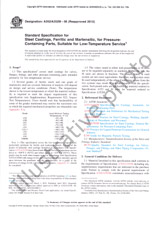We need your consent to use the individual data so that you can see information about your interests, among other things. Click "OK" to give your consent.
ASTM G28-02(2015)
Standard Test Methods for Detecting Susceptibility to Intergranular Corrosion in Wrought, Nickel-Rich, Chromium-Bearing Alloys
STANDARD published on 1.11.2015
The information about the standard:
Designation standards: ASTM G28-02(2015)
Note: WITHDRAWN
Publication date standards: 1.11.2015
SKU: NS-621322
The number of pages: 7
Approximate weight : 21 g (0.05 lbs)
Country: American technical standard
Category: Technical standards ASTM
The category - similar standards:
Annotation of standard text ASTM G28-02(2015) :
Keywords:
corrosion test, ferric sulfate, intergranular, nickel-rich,, ICS Number Code 77.120.40 (Nickel, chromium and their alloys)
Additional information
| Significance and Use | |||||||||||||||||||||||||||||||||
|
3.1 The boiling ferric sulfate-sulfuric acid test may be applied to the following alloys in the wrought condition:
3.2 This test method may be used to
evaluate as-received material and to evaluate the effects of
subsequent heat treatments. In the case of nickel-rich,
chromium-bearing alloys, the test method may be applied to wrought
and weldments of products. The test method is not applicable to
cast products.
|
|||||||||||||||||||||||||||||||||
| 1. Scope | |||||||||||||||||||||||||||||||||
|
1.1 These test methods cover two tests as follows: 1.1.1 Method A, Ferric Sulfate-Sulfuric Acid Test (Sections 3 – 10, inclusive)—This test method describes the procedure for conducting the boiling ferric sulfate—50 % sulfuric acid test which measures the susceptibility of certain nickel-rich, chromium-bearing alloys to intergranular corrosion (see Terminology G15), which may be encountered in certain service environments. The uniform corrosion rate obtained by this test method, which is a function of minor variations in alloy composition, may easily mask the intergranular corrosion components of the overall corrosion rate on alloys N10276, N06022, N06059, and N06455. 1.1.2 Method B, Mixed Acid-Oxidizing Salt Test (Sections 11 – 18, inclusive)—This test method describes the procedure for conducting a boiling 23 % sulfuric + 1.2 % hydrochloric + 1 % ferric chloride + 1 % cupric chloride test which measures the susceptibility of certain nickel-rich, chromium-bearing alloys to display a step function increase in corrosion rate when there are high levels of grain boundary precipitation. 1.2 The purpose of these two test methods is to detect susceptibility to intergranular corrosion as influenced by variations in processing or composition, or both. Materials shown to be susceptible may or may not be intergranularly 1.3 This standard does not purport to address all of the safety concerns, if any, associated with its use. It is the responsibility of the user of this standard to establish appropriate safety and health practices and determine the applicability of regulatory limitations prior to use. Warning statements are given in 5.1.1, 5.1.3, 5.1.9, 13.1.1, and 13.1.11. |
|||||||||||||||||||||||||||||||||
| 2. Referenced Documents | |||||||||||||||||||||||||||||||||
|
We recommend:
Technical standards updating
Do you want to make sure you use only the valid technical standards?
We can offer you a solution which will provide you a monthly overview concerning the updating of standards which you use.
Would you like to know more? Look at this page.




 Cookies
Cookies
